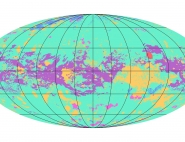A far-off cousin of African salt pans found on Titan
A far-off cousin of African salt pans found on Titan
Except the Earth, Titan, Saturn's biggest moon, is the only known planetary body able to bear stable liquids on its surface. On Titan, a full hydrocarbon cycle, similar to the water cycle on Earth, is based on carbon, hydrogen and nitrogen molecules and involves the atmosphere, the surface and the subsurface. Titan's hydrocarbon lakes, discovered thanks to the Cassini mission, are integral part of this process.
A new study analyzing Cassini's data indicates that the lake known as Ontario Lacus on Titan behaves in a similar way to what we call a "salt pan" on Earth.
Ontario Lacus is the largest lake of Titan's southern hemisphere. It is a large 230 km-long and 75 km-wide topographic depression, only few meters-deep. It is located in a wide and flat sedimentary basin several hundred kilometers-wide, bordered by small mountains at most few hundred meters-high.
Recently, a group from the University of Nantes (France) led by Thomas Cornet, a Cassini mission associate, found evidences for the existence of time-stable channels between 2007 and 2010, carved onto the lake bed and located inside its southern part. This suggests that Ontario Lacus, so far supposed completely filled by liquid hydrocarbons (mainly methane and ethane), could actually be a flat-floored topographic depression, drying and refilling thanks to underground liquids, thus forming liquid areas surrounded by wet materials (probably sands or muds).
"We concluded that the solid floor of Ontario Lacus is in fact probably exposed in those areas" says Thomas Cornet, whose paper has been recently published in the journal Icarus.
These characteristics make Ontario Lacus very similar to ephemeral lakes called "salt pans" on Earth, and among these, to the Etosha pan, located in a semi-arid region in Namibia (South of Africa).
![]()
Ontario Lacus (230 x 75 km, Titan) and the Etosha pan (120 x 65 km, Namibia), two ephemeral lakes separated by 1.4 billion kilometers. Image credits: NASA/ESA/LPGNantes.
The Etosha pan is an example of big sized ephemeral lake on Earth. Its dimensions are comparable to those of Ontario Lacus on Titan. During the rainy season, the water table, usually lying few decimeters below the surface, is abundantly fed in water and inundates some or all parts of the Etosha pan. Liquids then rapidly evaporate because of the extreme aridity of this environment.
"On Earth, salt pans tend to form in deserts where liquids can suddenly accumulate. So it appears the same thing is happening on Titan." said Bonnie Buratti, a co-author and Cassini team member based at NASA's Jet Propulsion Laboratory in Pasadena, California.
Titan's climate is characterized by torrential rainfalls occurring during sporadic rainstorms, with evaporation rates greater than mean precipitation rates. This disequilibrium between evaporation and precipitation is the factor determining the aridity of a climate, and it is thus likely that Titan's climate is arid.
The strong similarities between Ontario Lacus and the Etosha pan, inferred from the morphology and the climate, suggest that they could have formed similarly.
The Etosha pan has developed by dissolution, over several million years, of a calcareous layer covering the sedimentary basin where it lies. Ontario Lacus would result from the dissolution of a geological surface layer, formed by the solid hydrocarbons produced in the atmosphere, accumulating onto Titan's surface and which are soluble in liquid methane and ethane.
"These results emphasize the importance of comparative planetology in modern planetary sciences: finding familiar geological features on alien worlds like Titan allows us to test the theories explaining their formation," said Nicolas Altobelli, ESA's Cassini-Huygens project scientist.
The observations have been made by the Cassini orbiter, part of the NASA, ESA and Italian Space Agency Cassini-Huygens mission to Saturn's system.
Related publication:
"Geomorphological Significance of Ontario Lacus on Titan: Integrated interpretation of Cassini VIMS, ISS and RADAR data and comparison with the Etosha Pan (Namibia)," by T. Cornet, O. Bourgeois, S. Le Mouélic, S. Rodriguez, C. Sotin, T. Lopez Gonzalez, G. Tobie, C. Fleurant, J.W. Barnes, R.H. Brown, K.H. Baines, B.J. Buratti, R.N. Clark and P.D. Nicholson, Icarus 218(2), 788-806, April 2012, doi:10.1016/j.icarus.2012.01.013
Also read the articles about this subject on ESA's website, JPL's website and Planetary Science Institute's website.


